|
Calidris ferruginea (Curlew
sandpiper)
Krombekstrandloper [Afrikaans]; Krombekstrandloper
[Dutch]; Bécasseau cocorli [French]; Sichelstrandläufer [German];
Pilrito-de-bico-comprido [Portuguese]
Life
> Eukaryotes >
Opisthokonta
> Metazoa (animals) >
Bilateria >
Deuterostomia > Chordata >
Craniata > Vertebrata (vertebrates) > Gnathostomata (jawed
vertebrates) > Teleostomi (teleost fish) > Osteichthyes (bony fish) > Class:
Sarcopterygii (lobe-finned
fish) > Stegocephalia (terrestrial
vertebrates) > Tetrapoda
(four-legged vertebrates) > Reptiliomorpha > Amniota >
Reptilia (reptiles) >
Romeriida > Diapsida > Archosauromorpha > Archosauria >
Dinosauria
(dinosaurs) > Saurischia > Theropoda (bipedal predatory dinosaurs) >
Coelurosauria > Maniraptora > Aves
(birds) >
Order: Charadriiformes > Family: Scolopacidae
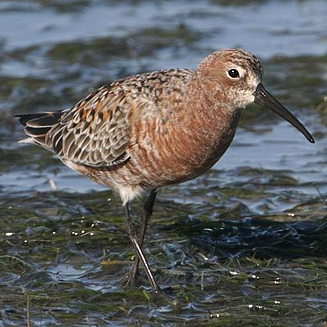 |
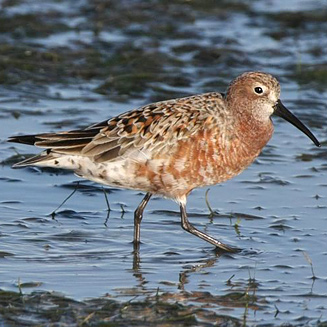 |
| Curlew sandpiper in breeding plumage,
West Coast National Park, South Africa..
[photo Trevor Hardaker ©] |
Curlew sandpiper in breeding plumage, West Coast
National Park, South Africa.. [photo Trevor Hardaker ©] |
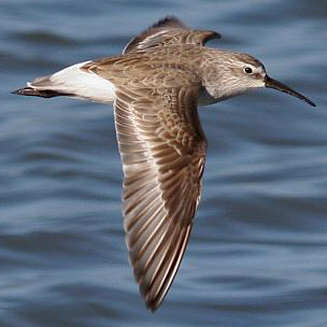 |
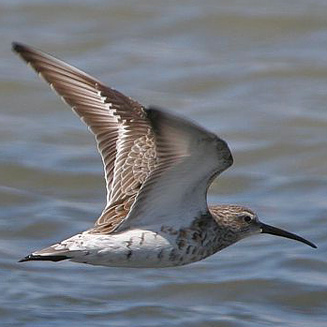 |
| Curlew sandpiper in non-breeding
plumage, West Coast National Park, South Africa.. [photo Trevor Hardaker ©] |
Curlew sandpiper in non-breeding plumage, West
Coast National Park, South Africa.. [photo Trevor Hardaker ©] |
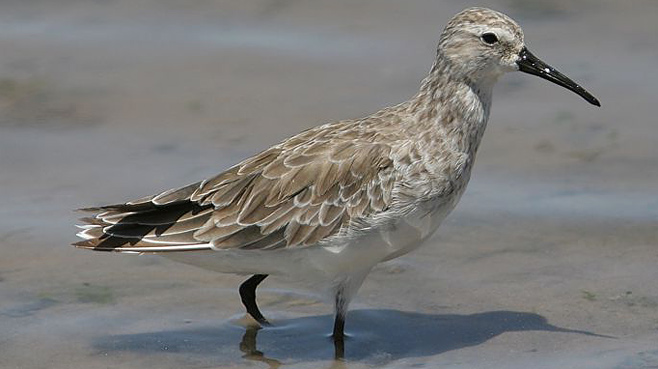 |
|
Curlew sandpiper in non-breeding plumage, West
Coast National Park, South Africa. [photo Trevor Hardaker ©] |
Distribution and habitat
Breeds in coastal of Arctic tundra above 70° North, from
the Jamal Peninsula, western Siberia to the Bering Strait and north-western
Alaska. In the non-breeding season it heads below 20° North, from the Indian
Ocean islands to New Zealand and sub-Saharan Africa, from Mauritania to Somalia
south to southern Africa. Here it is common in patches across the region,
generally preferring coastal estuaries, lagoons, sheltered and open shores with
stranded algae and wetlands with muddy fringes.
|
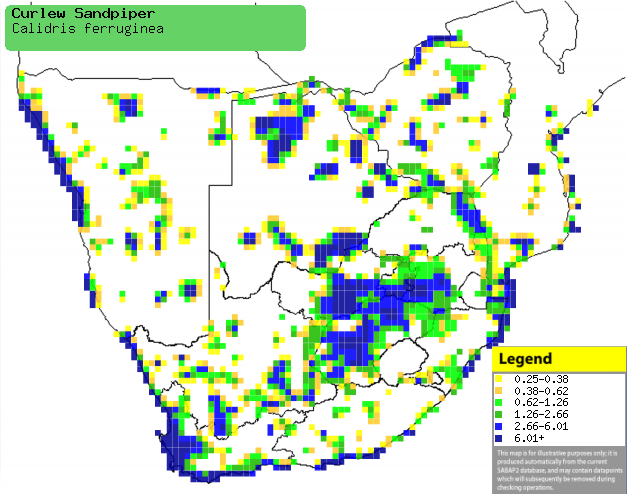 |
|
Distribution of Curlew sandpiper in southern Africa,
based on statistical smoothing of the records from first SA Bird Atlas
Project (©
Animal Demography unit, University of
Cape Town; smoothing by Birgit Erni and Francesca Little). Colours range
from dark blue (most common) through to yellow (least common).
See here for the latest distribution
from the SABAP2. |
Predators and parasites
In 1995 10% of its population at Strandfontein Sewage
Works, Western Cape due to Botulism (Clostridium botulinum) Type C. It
has also been recorded as prey of the following animals:
Movements and migrations
All southern African birds breed in
west-central Siberia, with adults arriving in southern Africa from
August-November and leaving again in March and April. Juveniles
typically arrive about 4 weeks later than the adults and usually
stay in the region over winter before joining the next group of
migrants back to the breeding grounds. The proportion of juveniles
varies greatly according to the population of lemmings (Dicrostonyx
torquatus and Lemmus sibiricus) at its Siberian breeding
colonies. This is caused by the fact that lemmings are the main prey
of Arctic foxes (Alopex lagopus) and are generally scarce
every third year, which causes the foxes to switch to preying on
ground-nesting bird's eggs and chicks. In years when lemmings are
abundant, juveniles form approximately 12-65% of all Curlew
sandpipers in southern Africa but in years when lemmings are scarce
this figure drops to just 0.2-11%.
Food
It mainly eats invertebrates, doing most of its foraging on
mudflats, pecking and probing the soft mud in search of food; generally single
birds are less successful than foraging flocks. Females are faster and more
effective foragers than males but they feed on a smaller diversity of prey. The following food items have been recorded
in its diet:
- invertebrates
- Ceratonereis erythraeensis (Estuarine nereids)
- Assiminea globulus (Globular mud snails)
- Urothoe grimaldii (Burrowing amphipod)
- Hymenosoma orbiculare (Crown crab)
- Cleistostoma edwardsii (Sandflat crab)
- stratiomyid larvae
- nereid polychaetes
- Hydrobia (gastropods)
- insect adults, pupae and larvae
- Upogebia africana (Estuarine mudprawns)
Threats
Not threatened, in fact it has probably benefited from the
creation of dams and salt pans.
References
-
Hockey PAR, Dean WRJ and Ryan PG 2005. Roberts
- Birds of southern Africa, VIIth ed. The Trustees of the John Voelcker
Bird Book Fund, Cape Town.
|
